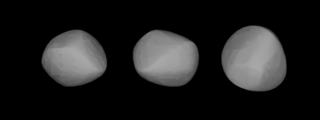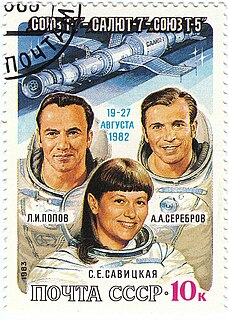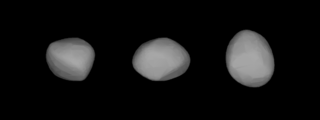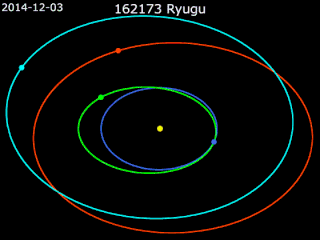
The asteroid belt is a torus-shaped region in the Solar System, located roughly between the orbits of the planets Jupiter and Mars, that is occupied by a great many solid, irregularly shaped bodies, of many sizes but much smaller than planets, called asteroids or minor planets. This asteroid belt is also called the main asteroid belt or main belt to distinguish it from other asteroid populations in the Solar System such as near-Earth asteroids and trojan asteroids.

Pomona is a stony main-belt asteroid that is 81 km in diameter. It was discovered by German-French astronomer Hermann Mayer Salomon Goldschmidt on October 26, 1854, and is named after Pōmōna, the Roman goddess of fruit trees.
Felicitas is a dark and fairly large main-belt asteroid. It was discovered by German-American astronomer C. H. F. Peters on October 9, 1869, and named after Felicitas, the Roman goddess of success. The only observed stellar occultation by Felicitas is one from Japan.

Lydia (minor planet designation: is a large belt asteroid with an M-type spectrum, and thus may be metallic in composition, consisting primarily of nickel-iron. It was discovered by French astronomer Alphonse Borrelly on April 19, 1870 and was named for Lydia, the Asia Minor country populated by Phrygians. The Lydia family of asteroids is named after it.

Thyra is a fairly large and bright inner main-belt asteroid that was discovered by Canadian-American astronomer J. C. Watson on August 6, 1871 and was named for Thyra, the consort of King Gorm the Old of Denmark. Based upon its spectrum, it is categorized as a stony S-type asteroid.
Nobuhiro Kawasato is a Japanese astronomer credited by the Minor Planet Center with the discovery of 105 asteroids he made partially in collaboration with astronomer Tsutomu Hioki at Okutama Observatory, Japan, between 1988 and 2000.

Aleksandr Aleksandrovich Serebrov was a Soviet cosmonaut. He graduated from Moscow Institute of Physics and Technology (1967), and was selected as a cosmonaut on December 1, 1978. He retired on May 10, 1995. He was married and had one child.

Elvira is a typical main belt asteroid and is a member of the Koronis asteroid family. It was discovered by Auguste Charlois on 3 May 1888 in Nice. (277) Elvira is possibly named for a character in Alphonse de Lamartine’s Méditations poétiques (1820) and Harmonies poétiques et religieuses (1830).

Unitas is a typical main belt asteroid that was discovered by Elia Millosevich on 1 March 1891 in Rome. The asteroid was named by the director of the Modena Observatory in honor of the Italian astronomer Angelo Secchi. It is classified as an S-type asteroid.

Dodona is a large Main belt asteroid that was discovered by the French astronomer Auguste Charlois on 29 January 1894 in Nice. It is classified as an M-type asteroid.

Eulalia is a minor planet orbiting the Sun. Eulalia is very near the 3:1 Jupiter orbital resonance.
(9942) 1989 TM1, provisional designation 1989 TM1, is a background asteroid from the central region of the asteroid belt, approximately 4.5 kilometers (2.8 miles) in diameter. It was discovered on 8 October 1989, by Japanese astronomers Nobuhiro Kawasato and Tsutomu Hioki at the Okutama Observatory (877) in Japan. The asteroid has a tentative rotation period of 3.1 hours.
2927 Alamosa, provisional designation 1981 TM, is a stony background asteroid from the central region of the asteroid belt, approximately 12 kilometers in diameter. The asteroid was discovered on 5 October 1981, by American astronomer Norman Thomas at Lowell's Anderson Mesa Station in Flagstaff, Arizona. The S-type asteroid has a rotation period of 4.4 hours. It was named after the U.S. town of Alamosa in Colorado.
1621 Druzhba, provisional designation 1926 TM, is a stony Florian asteroid and relatively slow rotator from the inner regions of the asteroid belt, approximately 10 kilometers in diameter. It was discovered on 1 October 1926, by Russian astronomer Sergey Belyavsky at Simeiz Observatory on the Crimean peninsula. It was named after the Russian word for friendship.
4997 Ksana, provisional designation 1986 TM, is a carbonaceous Palladian asteroid from the outer region of the asteroid belt, approximately 10 kilometers in diameter. It was discovered on 6 October 1986, by Russian astronomer Lyudmila Karachkina at Crimean Astrophysical Observatory on the Crimean peninsula. The asteroid was named for Russian chemist Kseniya Nessler.
1625 The NORC, provisional designation 1953 RB, is a carbonaceous asteroid from the outer region of the asteroid belt, approximately 55 kilometers in diameter. It was discovered on 1 September 1953, by Belgian astronomer Sylvain Arend at the Royal Observatory of Belgium in Uccle, Belgium. It was named after the IBM Naval Ordnance Research Calculator (NORC).
2228 Soyuz-Apollo, provisional designation 1977 OH, is a carbonaceous Themistian asteroid from the outer region of the asteroid belt, approximately 26 kilometers in diameter. It was discovered on 19 July 1977, by Soviet–Russian astronomer Nikolai Chernykh at the Crimean Astrophysical Observatory in Nauchnyj on the Crimean peninsula. It was named after the Apollo–Soyuz Test Project.
31179 Gongju, provisional designation 1997 YR2, is a stony Nysian asteroid from the inner regions of the asteroid belt, approximately 5 kilometers (3 miles) in diameter. It was discovered on 21 December 1997, by Japanese amateur astronomer Naoto Sato at his Chichibu Observatory near Tokyo, central Japan. The S-type asteroid has a rotation period of 4.8 hours and possibly an elongated shape. It was named for the South Korean city of Gongju.








